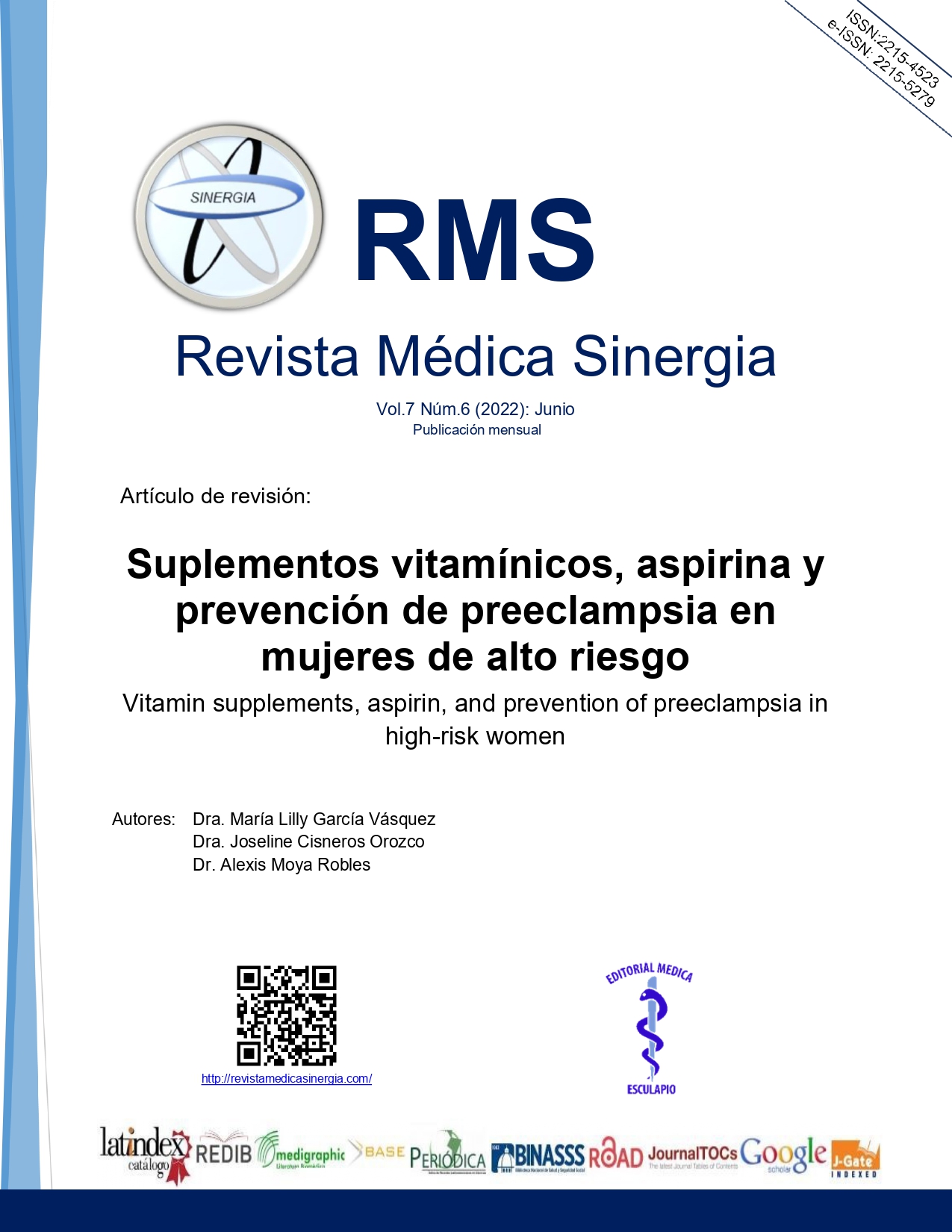Abstract
Preeclampsia is defined as a hypertensive disease specific to pregnancy with multisystem involvement, which generally occurs after 20 weeks of gestation and represents one of the most frequent hypertensive disorders during this stage, causing not only greater morbidity and mortality for the mother but also for the product, in this lies the importance of providing adequate and timely management to patients who present this pathology, in order to reduce complications both in pregnancy, in childbirth and after it for the mother and the product.
The diagnosis of preeclampsia and any other type of hypertensive disorder during pregnancy is based on prenatal control, through blood pressure measurements at each consultation and assessment of the presence or absence of associated symptoms, mainly the presence of symptoms of severity, these being of vital importance to guide the treating physician on the decisions to be made with these patients and thus establish the most appropriate management. The prevention of preeclampsia is the main way to reduce possible catastrophic scenarios for mothers and their products, currently many methods have been proposed that seek to prevent the appearance of preeclampsia in high-risk women mainly or to minimize the complications that this pathology can provoke, the main ones being the use of aspirin and some supplements.
Keywords
References
Mora JL. Preeclampsia-eclampsia [Internet]. Redalyc.org. [citado el 17 de marzo de 2022]. Disponible a partir de: https://www.redalyc.org/pdf/1702/170216979004.pdf
Pacheco-Romero J. Introduction to the Preeclampsia Symposium. Rev Peru Ginecol Obstet. 2017;63(2):199-206.Disponible a partir de http://www.scielo.org.pe/pdf/rgo/v63n2/a07v63n2.pdf
Herrera K. Preeclampsia. Revista Médica Sinergia. 2018;3(3):8-12. Disponible a partir de: https://www.medigraphic.com/pdfs/sinergia/rms-2018/rms183b.pdf
DeCherney A, Nathan L, Lauter N, Roman A. Diagnósticos y tratamientos gnecoobstetricos. Edición 11. México: Mc Graw Hill; 2013.
Elizabeth C, Oyaque C, Estefanía M, Tapia M, Alexandra T, Elizabeth C, et al. Factores de riesgo y predictores de preeclampsia: una mirada al futuro [Internet]. Revhipertension.com. [citado el 21 de febrero de 2022]. Disponible a partir de: https://www.revhipertension.com/rlh_1_2018/factores_riesgo_predictores.pdf
Williams B, Mancia G, Spiering W et al. Guía ESC/ESH 2018 sobre el diagnóstico y tratamiento de la hipertensión arterial. Revista Española Cardiol. 2019;72(2):160.e1-e78.
Dulay A. Preeclampsia y eclampsia. Manual MSD [Internet] 2017 [consultado el 03 de abril de 2020]. Disponible a partir de:
Katzung B, Masters S, Trevor A. Farmacología Básica y Clínica. Edición 12. México: Mc Graw Hill; 2012.
Voutetakis A, Panagiota P, Kanaka-Gantenbein C. Aspirin for the Prevention of Preeclampsia and Potential conseuences for fetal Brain Development. JAMA Pediatrics. 2019;173(7):619-620. Disponible a partir de: https://jamanetwork.com/journals/jamapediatrics/article-abstract/2734744?resultClick=1
Hernández M, Zayas M, Escobar. Utilidad del ácido acetil salicílico en la prevención de la preeclampsia. Acta Medica del centro. 2019; 13(1):110-118. Disponible a partir de: https://www.medigraphic.com/pdfs/medicadelcentro/mec-2019/mec191o.pdf
Rumbold A, Duley L, Crowther CA, Haslam RR. Antioxidants for preventing pre-eclampsia. Cochrane Database Syst Rev [Internet]. 2008 [citado el 21 de febrero de 2022];(1):CD004227. Disponible a partir de: https://www.cochranelibrary.com/es/cdsr/doi/10.1002/14651858.CD004227.pub3/full/es
González-Wong C, Fuentes-Barría H, Aguilera-Eguía R, Urbano-Cerda S, Vera-Aguirre V. El rol de la vitamina D sobre el riesgo de preeclampsia: Revisión narrativa. Rev Chil Nutr [Internet]. 2021 [citado el 21 de febrero de 2022];48(1):118–25. Disponible a partir de: https://www.scielo.cl/scielo.php?script=sci_arttext&pid=S0717-75182021000100118&lng=es&nrm=iso&tlng=es
Organización Panamericana de la Salud. Synthesis of evidence and recommendations for the management of calcium supplementation before and during pregnancy for the prevention of preeclampsia and its complications. Rev Panam Salud Publica [Internet]. 2021 [citado el 21 de febrero de 2022];45:e134. Disponible a partir de: https://www.ncbi.nlm.nih.gov/labs/pmc/articles/PMC8559666/
Gu W, Lin J, Hou Y. Effects of low-dose aspirin on the prevention of preeclampsia and pregnancy outcomes: A randomized controlled trial from Shanghai, China. Elsevier [Internet] 2020 [consultado el 03 de abril de 2020];248(7). Disponible a partir de: https://www.sciencedirect.com/science/article/pii/S0301211520301548
Navaratnam K, Alfirevic A, Jorgensen A et al. Aspirin non-responsiveness in pregnant women at high-risk of pre-eclampsia. Elsevier [Internet]. 2018 [ consultado 2 Ab 2020]; 221 (6). Disponible a partir de:
https://www.sciencedirect.com/science/article/pii/S0301211517306048
Banala C, Moreno S, Cruz Y, et al. Impact of the ACOG guideline regarding low-dose aspirin for prevention of superimposed preeclampsia in women with chronic hypertension. Elsevier [Internet]. 2020 [consultado el 02 de abril de 2020]. Disponible a partir de https://www.sciencedirect.com/science/article/abs/pii/S0002937820303227
Navarri-Ramos I, Tarrats-Velasco L, Páez-Maldonado I, Jiménez-Rodríguez JM, Alonso-Fernández S. La vitamina D durante la gestación Vitamin D during gestation [Internet]. Federacion-matronas.org. [citado el 21 de febrero de 2022].
Hofmeyr GJ, Lawrie TA, Atallah ÁN, Torloni MR. Calcium supplementation during pregnancy for preventing hypertensive disorders and related problems. Cochrane Libr [Internet]. 2018 [citado el 21 de febrero de 2022];2018(10). Disponible a partir de: https://www.cochranelibrary.com/es/cdsr/doi/10.1002/14651858.CD001059.pub5/full/es

This work is licensed under a Creative Commons Attribution-NonCommercial 4.0 International License.
Copyright (c) 2022 Array


